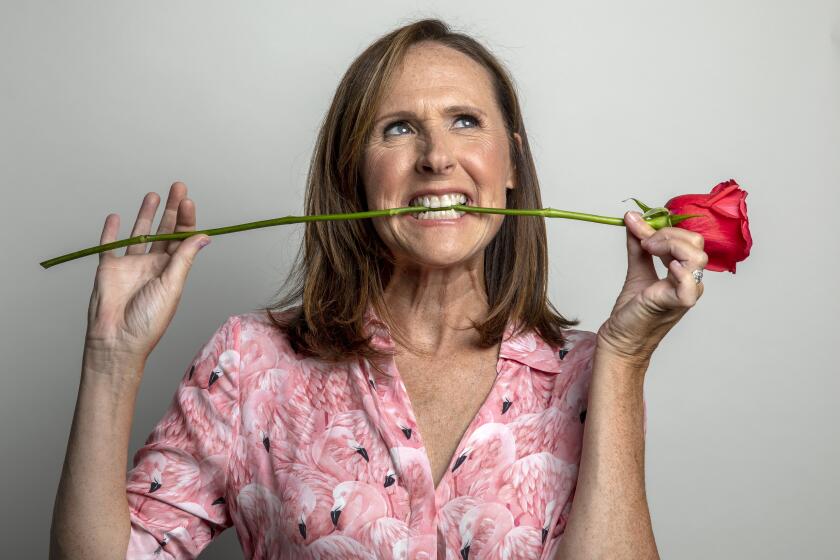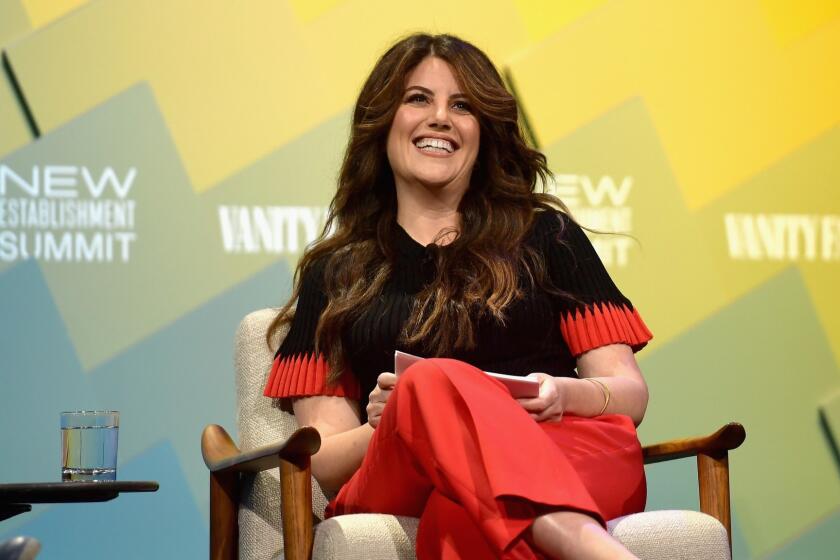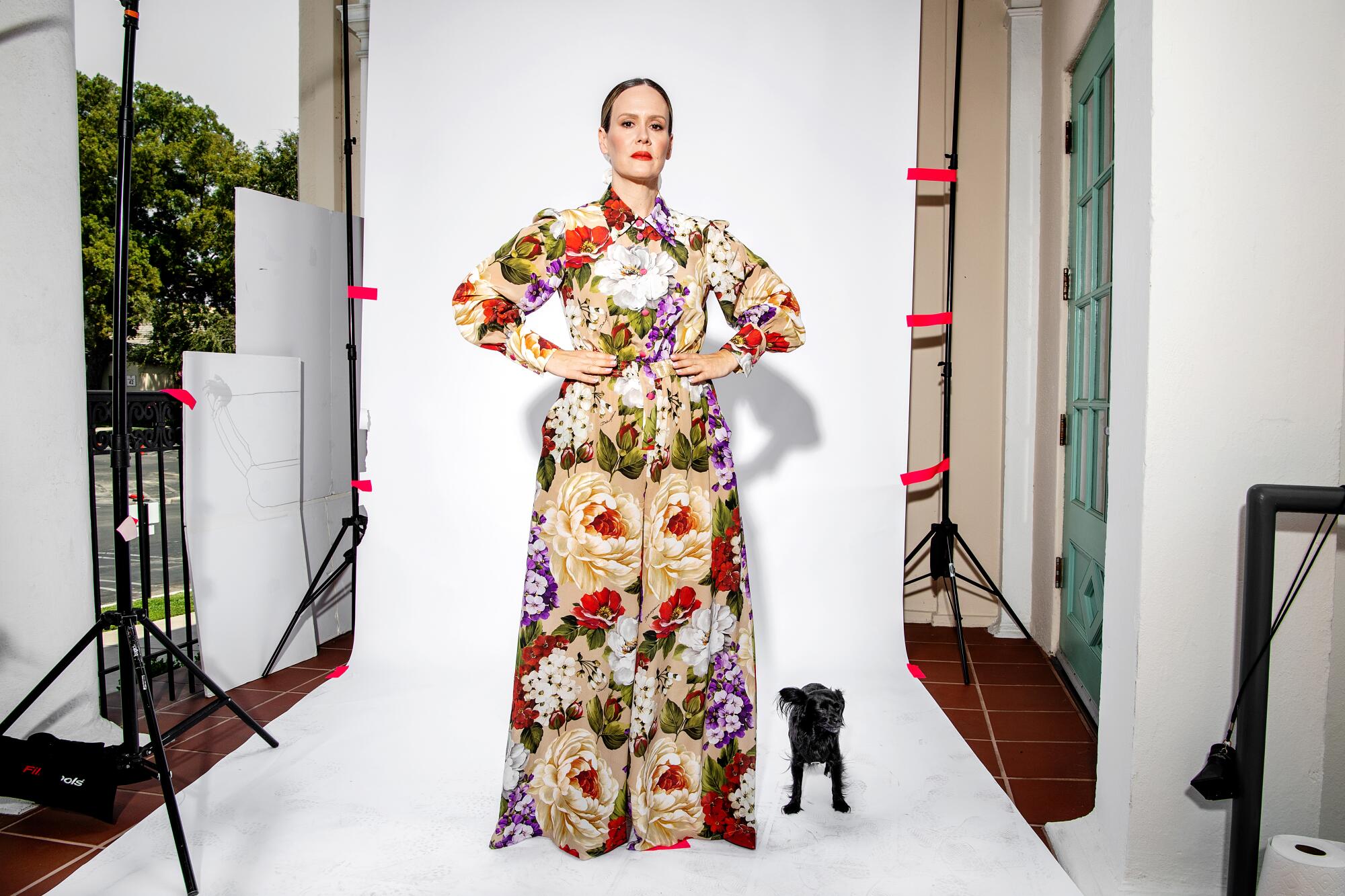
“I’m still wearing her ring, by the way,” Sarah Paulson says, catching a glimpse of it on her right hand.
She’s sitting under the summer sky in her backyard’s dining nook, where she’s been untangling the emotional weight of portraying Linda Tripp, the former White House secretary who exposed the Bill Clinton-Monica Lewinsky affair, for the FX series “Impeachment: American Crime Story.” Filming wrapped less than 24 hours ago, so it’s little wonder Tripp’s gravitational pull hasn’t eased. Not that Paulson expects it will anytime soon.
“It feels almost like she’s stuck to me,” she says.
The complete guide to home viewing
Get Screen Gab for everything about the TV shows and streaming movies everyone’s talking about.
You may occasionally receive promotional content from the Los Angeles Times.
Her prep work began in earnest in fall 2019, after completing back-to-back TV projects: first as one of fiction’s most unforgettable villains, Nurse Ratched, in Netflix’s “One Flew Over the Cuckoo’s Nest” origin story, “Ratched”; then as Alice Macray, a composite character in FX on Hulu’s “Mrs. America,” a limited series about the battle to pass the Equal Rights Amendment in the 1970s. Filming was slated to begin on “Impeachment” in March 2020, before the COVID-19 pandemic stymied Hollywood productions. With five months of initial preparation, eight months of delays and 10 months shooting, Paulson has spent nearly two years immersed in Tripp.
“It’s like all vibrationally right under my nose for me,” she says, leading her fingers toward her nostrils for emphasis. Then comes the reveal about the ring. It’s a replica of Tripp’s — a textured gold band so wide it dwarfs the pear-shaped diamond it showcases. With her right thumb, Paulson has been rotating it along her ring finger — her nails too are still Tripp’ed-out, with a sheer French manicure.
It becomes clear that she is in mourning. And she’s well aware that will provoke some ridicule.
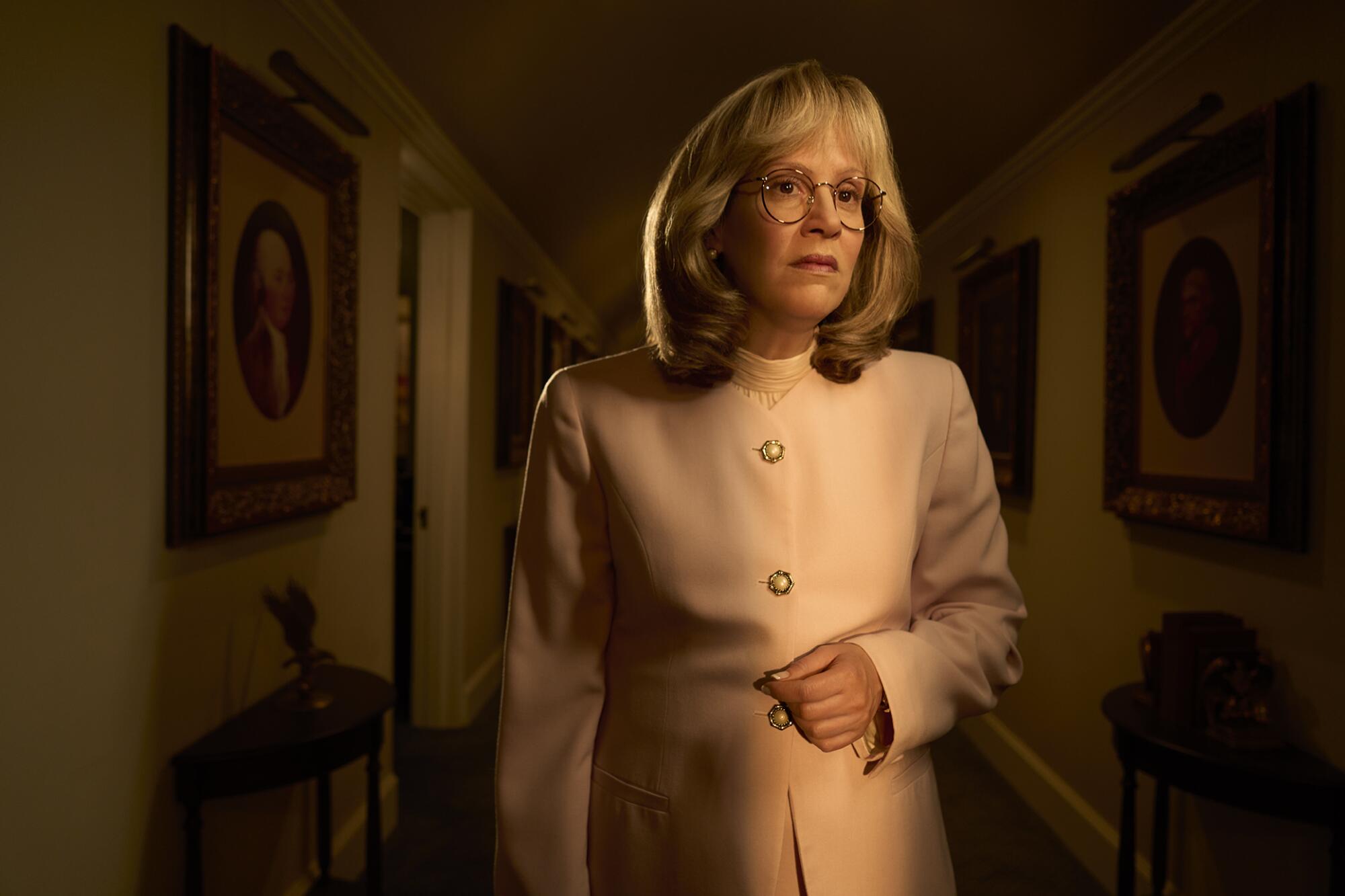
Paulson has good reason to expect it. In the late ’90s, Tripp became one of the most hated women in America and lived on in infamy as the worst friend ever. A career civil servant — she worked as a White House secretary during President George H.W. Bush’s administration and stayed on for the first two years of the Clinton presidency before being transferred to the Pentagon — Tripp was thrust into the spotlight over her role in one of the biggest political scandals in American history. She turned over evidence central to Clinton’s 1998 impeachment: 20 hours of secret recordings of her phone conversations with Lewinsky, a former White House intern Tripp befriended when they both worked at the Pentagon, that detailed Lewinsky’s affair with the president. The tapes revealed Tripp as a duplicitous friend, coaxing and manipulating Lewinsky to build a body of evidence against Clinton. Tripp, who long contended that she felt it was her moral duty to expose the abuse of power by the president, was alternately cast as hero, villain and joke in the ensuing media whirlwind, depending on whom you asked — a legacy that was rehashed after her death in April 2020 at age 70.
Paulson hopes to shed light on Tripp, of whom she has become protective: So deep is her partiality that during a virtual Q&A with press earlier in the day, Paulson became noticeably agitated by a reporter’s assessment of Tripp’s unlikability in the series — and in life. It turns out that Paulson’s performance might not prompt all viewers to reconsider their judgments of Tripp, a far cry from her arresting, Emmy-winning portrayal of Marcia Clark in “The People v. O.J. Simpson: American Crime Story,” which contributed to the redemption of the famed prosecutor who endured sexism and mockery in the courtroom and the court of public opinion.
“She really captured the rock and the hard place of it all,” Clark says of Paulson. “And the way it felt to just want to do my job. She really got all of that — the frustration of it, the injustice of it, that desire to just be a person instead of this cartoon character that the press really wanted to stand me up as.”
The Times TV team picks the series we’re most looking forward to this season.
Although the contempt Clark and Tripp faced just a few years apart was not identical, Paulson has come to think of the performances as bookends, both about women reduced to caricature by an unrelenting media circus.
“I think in the initial moment, I thought: ‘Oh, my God, I took a really big swing and I missed,” Paulson says later of the antipathy voiced about Tripp by a couple of reporters at the aforementioned press event. “Not only may it not affect anybody’s assessment of her, it might make people double down. And that is something I never thought of. And I don’t know if that makes me foolish, or it just makes me a person who was so invested in trying to be a person. ... I think Linda was certainly a victim of being caught up in a machine. Don’t get me wrong — she put the gas in the car, she put the keys in the ignition, and then she started driving, put her foot on the pedal. But then it’s like a runaway train — I know I just mixed my vehicle metaphors. I will never think that what she did was right. Far from it. But I do have a greater understanding as to the why.”
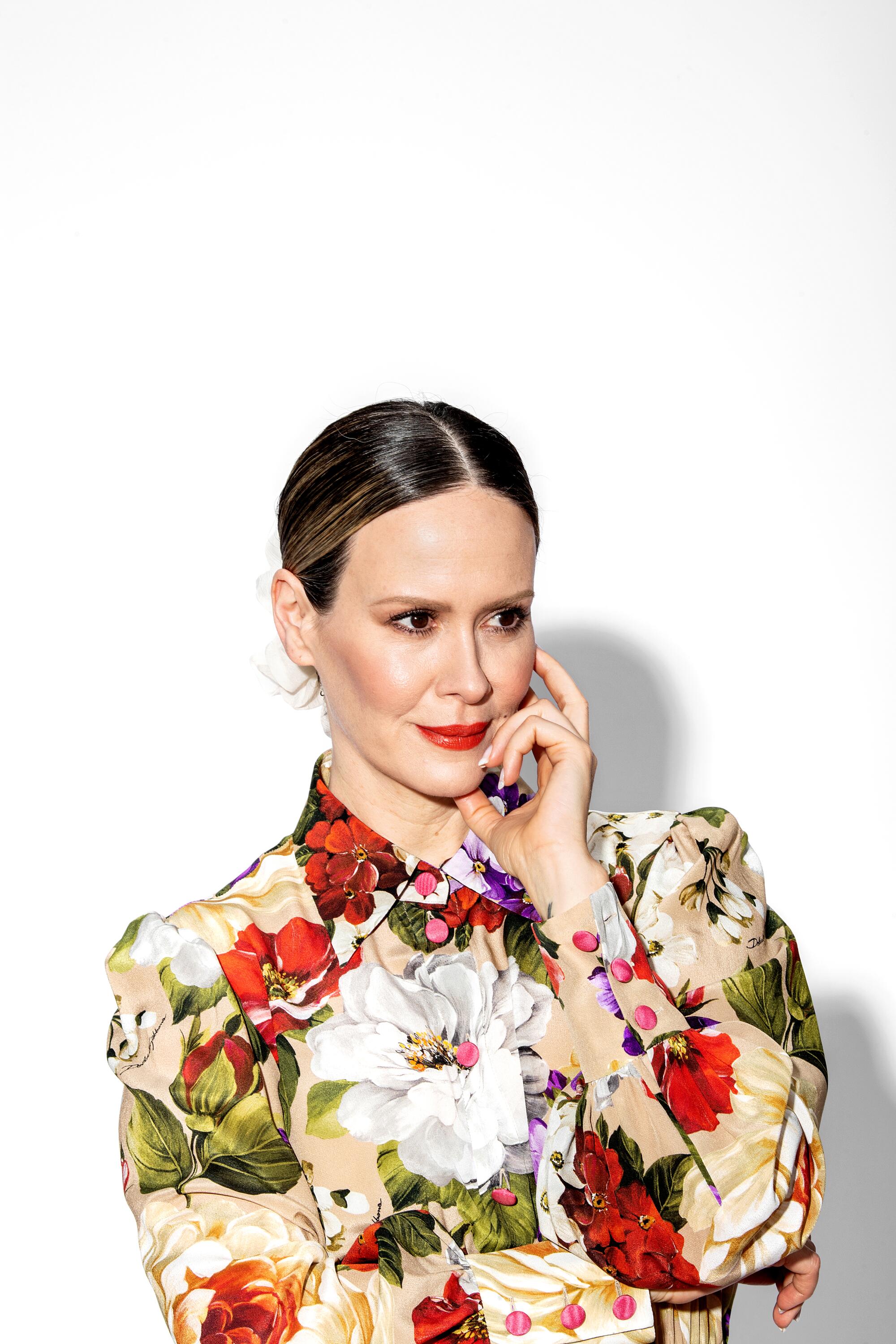
Viewers can make their own assessments when the latest season of Ryan Murphy’s anthology series premieres Sept. 7. Shepherded by head writer and executive producer Sarah Burgess, the 10-episode series revolves around the sex scandals that engulfed Clinton’s presidency — the sexual harassment lawsuit Paula Jones (Annaleigh Ashford) filed against the president (Clive Owen), as well as Clinton’s sexual relationship with Lewinsky (Beanie Feldstein) and the key figures, like Tripp, who became forever linked to it. (Lewinsky is a producer on the series.)
On the wood deck that surrounds the pool of her Hollywood Hills home, Paulson scoots around every so often in a billowy seafoam lounge dress to tend to the dogs: There’s her quarantine-adopted rescue, Winnie, as well as Luther and Shuggy — she’s dog-sitting the pair for friend and “Impeachment” co-star Elizabeth Reaser. Paulson is more warm and upbeat than some of the characters she’s brought to life onscreen, enthusiastically gabbing about TV shows she’s not starring in. She lights up at the mention of “The White Lotus,” the HBO limited series that recently delivered a whopper in its finale. “Ryan [Murphy] left me a message today and it’s just ‘The White Lotus’ theme song on my voicemail,” she says. “I can’t tell you how much I love it. And that poop scene — I was like, ‘WHAAAT? How did they do it? Was it a green screen? Was it a butt double who was like: “I’ll do the pooping”?’ I haven’t seen a lot of poop on television — like, real pooping.”
That’s the thing about Paulson. As much as she frets about her capabilities, she covets making an impact. And she has established herself as someone who can twist her image, whether through leading roles that reimagine well-known figures like Clark and Nurse Ratched or supporting ones that vividly conjure a range of characters: conjoined twins in the “American Horror Story” franchise, a merciless slaveowner’s wife in “12 Years a Slave,” a queer confidant in “Carol.”
Shannon’s comic roles are suffused with something darker, more complicated. “I don’t like when comedy people make fun of their characters,” she says.
“She loves nothing better than to lose herself in characters. She’s very interested in the process of becoming someone else,” says Murphy, who also cast Paulson as First Lady Mamie Eisenhower in the upcoming “American Horror Story: Double Feature.” “So whenever we’ve had conversations about very daunting roles — Marcia Clark, anything on ‘American Horror Story,’ ‘Ratched’ — if it seems challenging, it’s always an immediate yes. And then the anxiety builds in her creation of the character: like, ‘Oh, my God. Can I pull this off?’ And she always does. She puts a lot of pressure on herself.”
Maybe because she’s always had big dreams. During the Clinton years, Paulson was at the start of her onscreen career, trying to make a name for herself with roles in TV series like “American Gothic” and “Jack & Jill” and movies like “The Other Sister.”
“Back then,” Paulson says, “I wanted the unattainable: I wanted to be Julia Roberts. It was some fantasy. And because I was young enough, it didn’t really occur to me how it happens to one in a million. Then, slowly, it became about, ‘I just want to work to live.’”
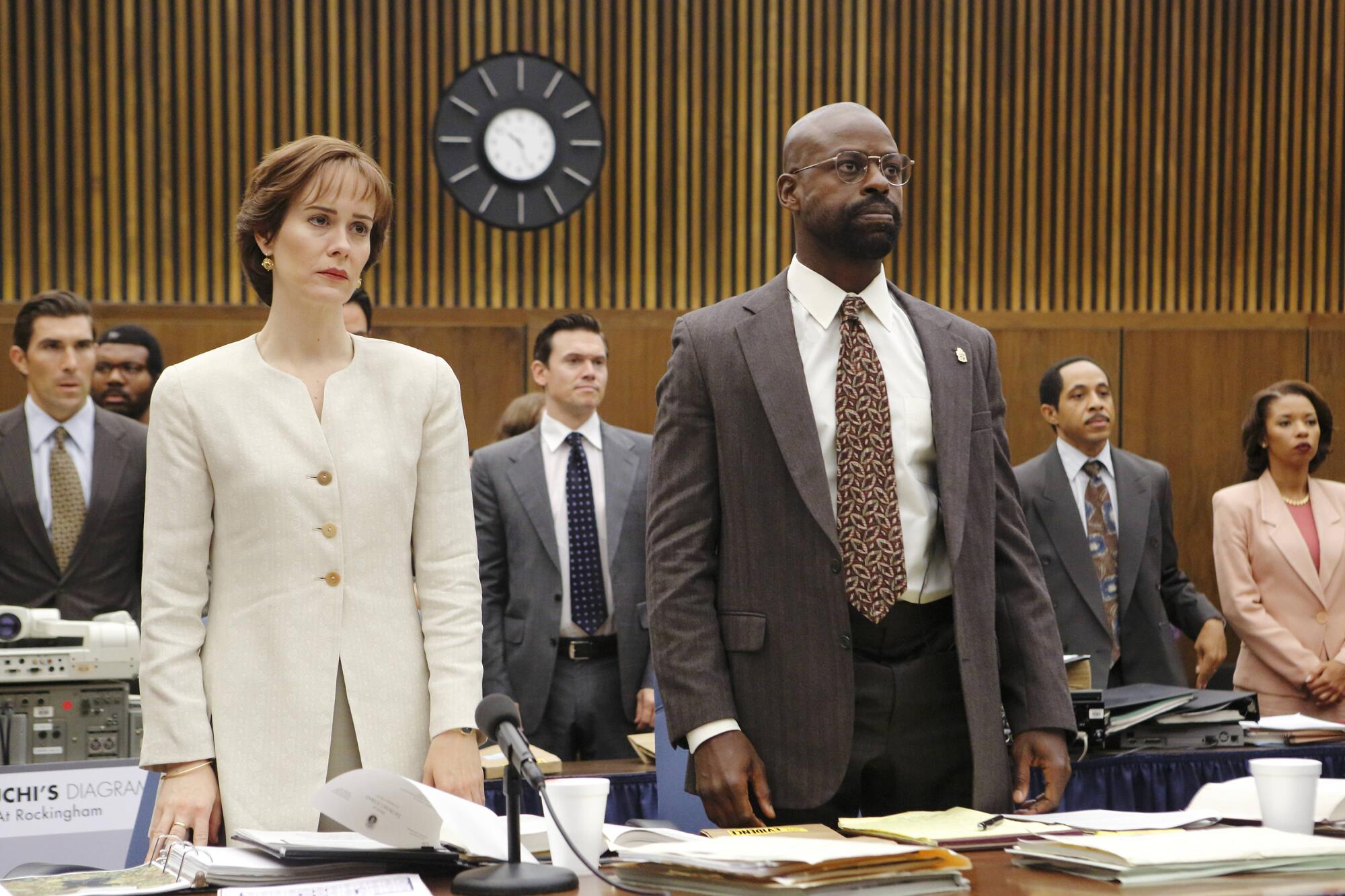
At age 46, Paulson has been carving a new career path: On “Impeachment,” as with “Ratched,” she is an executive producer as well as the star. She’s developing a project with actor Emmy Rossum. She’s especially eager to produce something she’s not starring in so she doesn’t have to split her focus.
Because when building a character, Paulson studies hard.
“Is she obsessive when it comes to her work? She sure is,” says Amanda Peet, the actress and writer who is Paulson’s best friend. “She tortures herself. But it’s because she’s desperate to be alive in the moment, so it doesn’t feel orchestrated.”
And Paulson succeeded, Burgess says, in creating “a real person”: “There are things implied in the writing that I understood better seeing her do it. I think when you write a character that’s complicated, what you could end up with is getting a take. ... I don’t think anybody is pure evil, and Sarah captured the nuance of that.”
As part of her preparation, Paulson listened to the second season of the “Slow Burn” podcast, which focuses on Clinton’s impeachment, and read several books, including Ken Gormley’s “The Death of American Virtue: Clinton vs. Starr” and Michael Isikoff’s “Uncovering Clinton: A Reporter’s Story.” (“I still carry it with me with all my page tabs,” she says of Isikoff’s book.) She watched every video sent over by the show’s research team. She listened to the Tripp-Lewinsky recordings. And she also spoke with a man who worked at the Pentagon with Tripp as an intern.
To evoke Tripp, Paulson spent three hours in hair and makeup, being outfitted with prosthetic teeth and a prosthetic nose, as well as a wig modeled after Tripp’s signature ’90s-style helmet of blond hair. Paulson worked with a dialect coach, Carla Meyer, to study Tripp’s voice and trained with a movement specialist, Julia Crockett, to understand Tripp’s mannerisms. Paulson also gained 30 pounds and wore additional padding — weighing roughly 4.5 pounds — to mimic Tripp’s shape, particularly in the upper body.
“Ratched” stars Sarah Paulson, Sharon Stone, Sophie Okonedo and Cynthia Nixon discuss their Netflix series, life in Hollywood and costar Judy Davis.
While lauded by her fans, Paulson’s casting as Tripp — a woman whose looks were lampooned on “Saturday Night Live” by John Goodman — also has led to a backlash on social media from those who call it a missed opportunity to cast a plus-size actress and another harmful example of Hollywood’s long history of fat phobia.
“It’s very hard for me to talk about this without feeling like I’m making excuses,” Paulson says. “There’s a lot of controversy around actors and fat suits, and I think that controversy is a legitimate one. I think fat phobia is real. I think to pretend otherwise causes further harm. And it is a very important conversation to be had. But that entire responsibility I don’t think falls on the actor for choosing to do something that is arguably — and I’m talking about from the inside out — the challenge of a lifetime. I do think to imagine that the only thing any actor called upon to play this part would have to offer is their physical self is a real reduction of the offering the actor has to make. I would like to believe that there is something in my being that makes me right to play this part. And that the magic of hair and makeup departments and costumers and cinematographers that has been part of moviemaking, and suspension of belief, since the invention of cinema. Was I supposed to say no [to the part]? This is the question.
“I think the thing I think about the most is that I regret not thinking about it more fully. And that is an important thing for me to think about and reflect on. I also know it’s a privileged place to be sitting and thinking about it and reflecting on it, having already gotten to do it, and having had an opportunity that someone else didn’t have. You can only learn what you learn when you learn it. Should I have known? Abso-f—ing-lutely. But I do now. And I wouldn’t make the same choice going forward.”
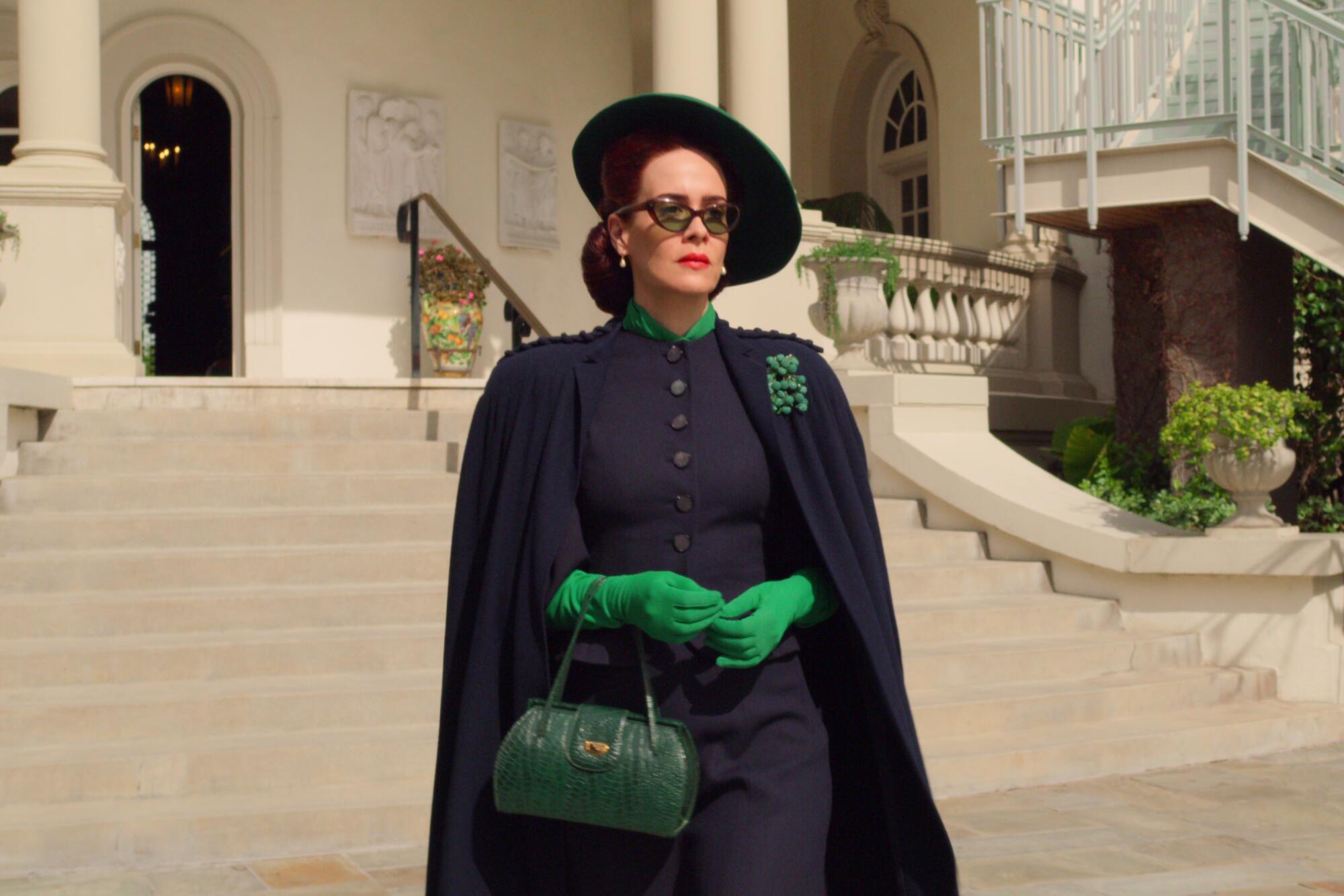
Paulson says it had been her “deepest, deepest hope” to meet Tripp, just as she did with Clark. “I don’t know if she would have wanted that at all. But maybe? I don’t know.”
But she did connect with the woman whom Tripp betrayed. Paulson and Lewinsky first met for dinner at Pizzeria il Fico in Los Angeles early in the process, and they talked on the phone or FaceTimed during the making of the series.
“I was interested in asking her about Linda, but I felt very, very shy to do that,” Paulson says. “I didn’t want to make her to have to move through my gnatty questions about a person that she probably has spent a lot of time either not thinking about at all [or] trying to excise that experience. I was conscious about, like, ‘God, if we were ever to do an interview together, how would I talk fully about what I feel about Linda without making her uncomfortable?’ Monica has never made me feel she couldn’t handle that. It’s just the awareness of, ‘I know this person is the linchpin, this person is the reason, so how can you listen to me talk about my love for her and how I wish I could travel to Middleburg and lie in her bed and smell her clothes?’”
If you were anywhere near a television in 1998, chances are you heard a joke — or a hundred — about Monica Lewinsky.
“She’s always incredibly gracious,” Lewinsky says of Paulson’s approach, although she admits being “severely triggered” by the uncanniness of the performance. “She’ll say, ‘I know this must be weird for you. This is what I’m feeling. I know that might be hard to understand.’ I can understand she sees Linda and experiences Linda in a different way than I did. She has embodied her. She has championed her and what she thinks her narrative is. Sure, that’s hard for me at times. She doesn’t know this but I worried a little in the beginning when we first got to know each other and had dinner and she was asking me questions. I thought, ‘Oh, my God. Is she going to try to befriend me and then betray me? What kind of actor is she? Is she going to try to see if she can do that?’ And, of course, I realized that was ridiculous.”
Lewinsky jokes that she and Feldstein have promised Paulson to “be Monica to her Tripp if she misses her too much,” and like most jokes, it contains an element of truth: Paulson has soaked in the character so long that Tripp reached into her subconscious.
A few weeks earlier, during production on the season’s penultimate episode, Paulson took a break from rehearsing a scene that delves into a formative event in Tripp’s upbringing: her father’s affair. Fully made up as Tripp at home — sporting washed-out mom jeans, a cream turtleneck and a wool sweater — Paulson revealed that she’d recently had her first dream about her complicated quarry.
“I couldn’t tell you what it was now; I don’t remember,” she said. “But in the moment, I was like, ‘I’ll never forget that.’”
More to Read
The complete guide to home viewing
Get Screen Gab for everything about the TV shows and streaming movies everyone’s talking about.
You may occasionally receive promotional content from the Los Angeles Times.

